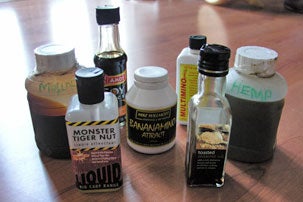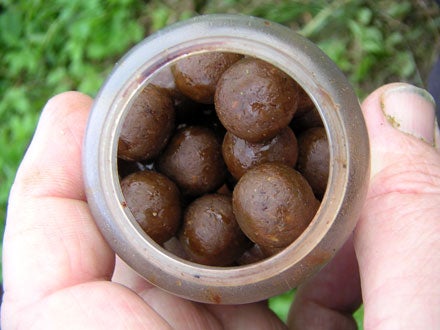First off, the three words that get thrown around are ‘dip’, ‘soak’, and ‘glug’. To me they are no different; it’s just for how long you put the bait in it. Dip means to literally dip it in before you cast, glug can be anything from an hour to a couple of years! Soak is somewhere in-between. I’ll use the word ‘glug’ from now on though. You can use almost anything, but you need to have a clear idea of why you’re glugging the bait in the first place. Are you trying to make that single hookbait more attractive as you’ll be casting out at 4.30pm and not recasting till 8 the next morning? Are you putting out a bed of bait and trying to attract attention to the hookbait? Don’t forget that many people use glugged, highly flavoured hookbaits these days, and many fish have been caught on them. Are you sure you want your bait to stick out like a sore thumb? Or are you trying to get attraction up into the water column to pull fish down onto the bait? The most basic glug is a couple of mil of your chosen flavour put into a bag and then shake your hookbaits around in it to boost the flavour – best done on frozen or air dried baits as they will tend to suck in the flavour. The downside to this is that it can make the bait slightly bitter (add a tiny bit of sweetener), and it can be a bit, well, obvious to the fish – especially pressured ones. Add too much and it could actually repel the fish. There are a few exceptions, like Hutchinson’s chocolate malt, which has a ‘natural’ base to the flavour, almost impossible to overdo. Food dips You then have what are called food dips. They add something more than just a strong smell to a bait and there are plenty of options such as fish oils/sauces, molasses, hemp oil, liquid liver, condensed milk, frankfurter brine; pretty much anything you use in the bait can be put on the outside as you’re trying to get the bait to scream “FOOD”! Rather than just be an interesting smell.
The advantage of ‘natural’ ingredients is that unlike synthetic flavours, they are almost impossible to overload. The ones to be careful with are fish oils, as they can go rancid if left in the warm too long, and CSL (Corn Steep Liquor) that can explode! Oils such as hemp, nut and olive oil, are less risky as they don’t go rancid as easily as fish oils, but moderation is the best policy. If using it on boilies, I tend to use whatever is in the mix, but drop the flavour. This should give you a highly attractive bait, but without the risk of overloading the bait with flavour. Dry powders Dry powders can be added, they can be something as simple as Nesquick or Horlicks, to additives such as betaine or powdered CSL. As always, coat the baits as they come out of the freezer, and watch it disappear as the bait defrosts! I’ve never really seen the point in literally dipping the bait in a thin glug and casting out straight away, a lot of it comes off on the cast, and most of the rest as it hits the water. Even though I use them, I also worry about baits that have been sitting in glugs for months/years as I always wonder about the state of the ingredients – enter the sticky dip! These are incredibly thick gooey liquids that stick to everything. Most are sold in different flavours, but some are neutral that you can add your own. The thing I really like about them is that you can coat the hookbait, then roll it in pellets/powdered attractors/hemp… just being a bit different to the norm. Just remember, if using pop-ups, to balance the bait BEFORE you glug it – look half way down our review and you’ll see why. Leaves a nice sludge around the hookbait as well. Don’t worry if the flavour combination seems odd – whilst we might not find a blend of chocolate malt and monster crab to our taste, remember to think fish, not human! But then we like sweet/sour and game/fruit so why shouldn’t they? How many times will that combination have been used? Why stop at hookbaits? When you think about it, we put loads of extra liquids into groundbait, why not the free baits? If you’re trying to stop the fish in their tracks, but the fish have grown wary of brightly coloured, flavoured baits then its worth trying free baits that have had liquid ingredients added to them as a soak – 20ml or so per kilo – put it in a bag and give it a shake (again, best on frozen/air dried baits). It’s a good way to customise readymade or shop bought boilies if you want to be a little different. Pellets take on liquids well and adding more oil can slow the breakdown rate. A word of caution. In the late 80’s/early 90’s it was all the rage to pour neat fish oils over the freebies before catapulting them out. Excellent method as you would see globules of oil rising out of the bait, a veritable wall of attraction that no fish could resist. The downside (other than everything smelling of salmon oil, you, your bivvy (probably why my viper doesn’t leak!), sleeping bag, food and most things within 20 yards of your swim) was a slick of Exxon Valdez proportions at the windward end of the lake if everyone did it! And as always some people took it to extremes, people started worrying about the health risk to the fish, so it fell out of favour. I still do it and it can be an absolutely killer method because there isn’t many that do! Check the lake rules before you do. So there you go, a couple of ideas and hopefully something you hadn’t thought of. Like dipping your method ball in hemp oil before casting it out…..or injecting bait dip inside Dynamite sticks…..or PVA bags of tiger nut slime…..or….!! |
Welcome!Log into your account












